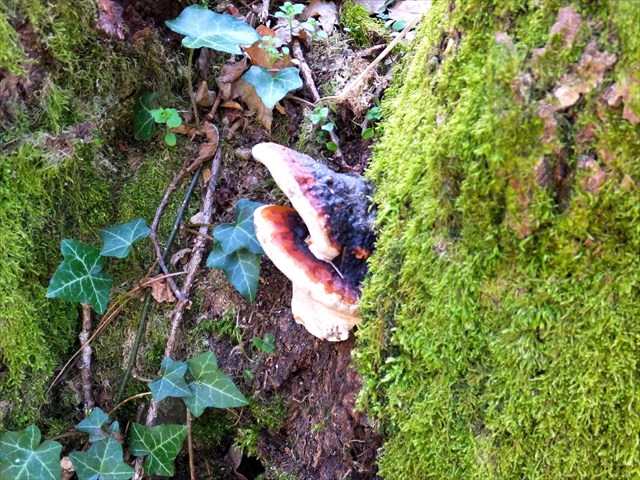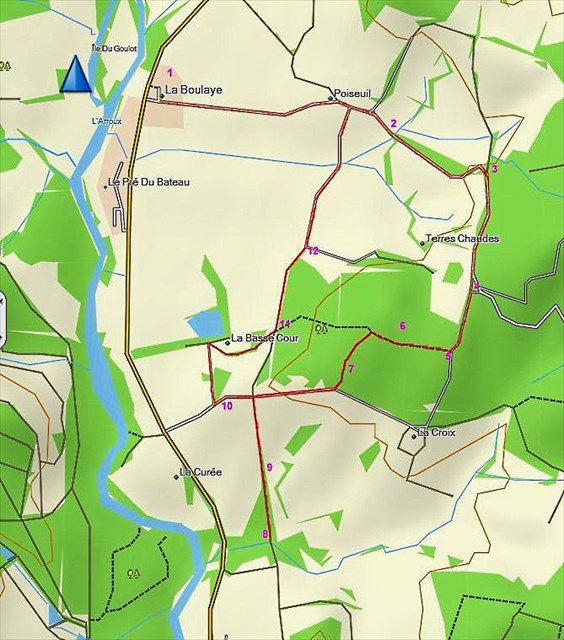Découvrir La Boulaye 3: Fomitopsis pinicola
Cette Cache est la troisième d'une série de 12 caches, qui vous permettra de découvrir La Boulaye pour une promenade d'environ 6 km. Vous pouvez trouver une carte du parcours ci-dessous.
Juste un peu d'étude de la nature pour vous tenir occupé …

Le Fomitopsis pinicola, de son nom vernaculaire, l'ungiline marginée ou polypore marginé, est un champignon polypore du genre Fomitopsis. L'espèce est commune dans tout l'hémisphère nord tempéré. Un nom binomial alternatif est Fomes pinicola.
Le bouchon est en forme de sabot ou triangulaire, la texture est dure et la taille jusqu'à 30-40 x 25 x 10 cm. La surface est plus ou moins lisse. Lorsqu'il pousse, il est de couleur orange-jaune, avec une marge blanche, puis plus tard la couleur vire au brun rougeâtre foncé et ensuite fréquemment avec une marge d'orange. La surface des pores est jaune pâle à brun-cuir. Il y a 3 à 4 pores par mm. Le fomitopsis pinicola pousse sur les conifères, ou (moins communs) les arbres à feuilles, vivants ou morts.
Comme les autres polypores, il persiste en développant une nouvelle couche de spore chaque année. Il pousse dès le printemps jusqu'au premières gelées.
Ce champignon n'est pas comestible en raison de sa texture de bois, mais il est utile en amadou.
Pince à épiler et stylos requis! S'il vous plaît replacer le cache exactement comme vous l'avez trouvé.

Amusez-vous sur la prochaine partie de la promenade.
Ici, vous pouvez voir le plan de la promenade:

This Cache is the third in a series of 12 caches, that will let you discover La Boulaye during a walk of about 6 km. You can find a map of the way above.
Just a little study of nature to keep you busy …
The Fomitopsis pinicola, its vernacular name is Red Banded polypore, is a fungus of the genus Ganoderma Fomitopsis. This species is common throughout the temperate northern hemisphere. An alternative binomial name is Fomes pinicola.
The cap is shaped triangular or like a hoof, the texture is hard and the size up to 30-40 x 25 x 10 cm. The surface is more or less smooth. When growing, it is orange - yellow colored with a white margin, and later the color changes to dark reddish brown and then frequently with an orange margin. The pore surface is the color of pale yellow-brown leather. There are 3-4 pores per mm. The fomitopsis pinicola grows on pine trees, or (less common) deciduous trees, alive or dead.
Like other polypores, it persists in developing a new layer of spore each year. It grows from spring until the first frosts.
This fungus is not edible because of its texture like wood, but it is useful as tinder.
Tweezers and pen required! Please replace the cache exactly like you hav found it!
Have fun on the next part of the walk.
Dieser Cache ist der dritte in einer Serie von 12 Caches, durch die Ihr auf einem Spaziergang von etwa 6 km La Boulaye entdecken könnt. Eine Karte mit der Strecke findet Ihr oben.
Nur ein bisschen Naturkunde, um Euch zu beschäftigen...
Der Fomitopsis pinicola, die einheimischen Bezeichnung ist Fichtenporling, ist ein Pilz aus der Gattung Ganoderma Fomitopsis. Diese Art ist in der gesamten gemäßigten nördlichen Halbkugel verbreitet. Ein alternativer binomischer Name ist Fomes pinicola.
Die Kappe ist dreieckig geformt oder wie ein Huf, die Textur ist hart und er hat eine Größe bis zu 30-40 x 25 x 10 cm. Die Oberfläche ist mehr oder weniger glatt. Während des Wachstums ist er orange - gelb gefärbt, mit einem weißen Rand, und später wechselt die Farbe zu einem Dunkelrotbraun, dann häufig mit einem orangefarbenen Rand. Die Porenoberfläche hat die Farbe von hellem gelb-braunem Leder. Es gibt 3-4 Poren pro mm. Der Fomitopsis pinicola wächst auf Nadelbäumen, oder (weniger häufig) Laubbäumen, tot oder lebendig.
Wie andere Polypores, bildet er bei der Entwicklung pro Jahr eine neue Schicht von Sporen. Er wächst vom Frühjahr bis zum ersten Frost.
Dieser Pilz ist nicht essbar, wegen der holzigen Textur, aber er ist nützlich als Zunder.
Pinzette und Stift werden benötigt! Bitte platziert den Cache wieder geanu so wie Ihr ihn gefunden habt!
Viel Spaß auf den nächsten Teil der Wanderung.